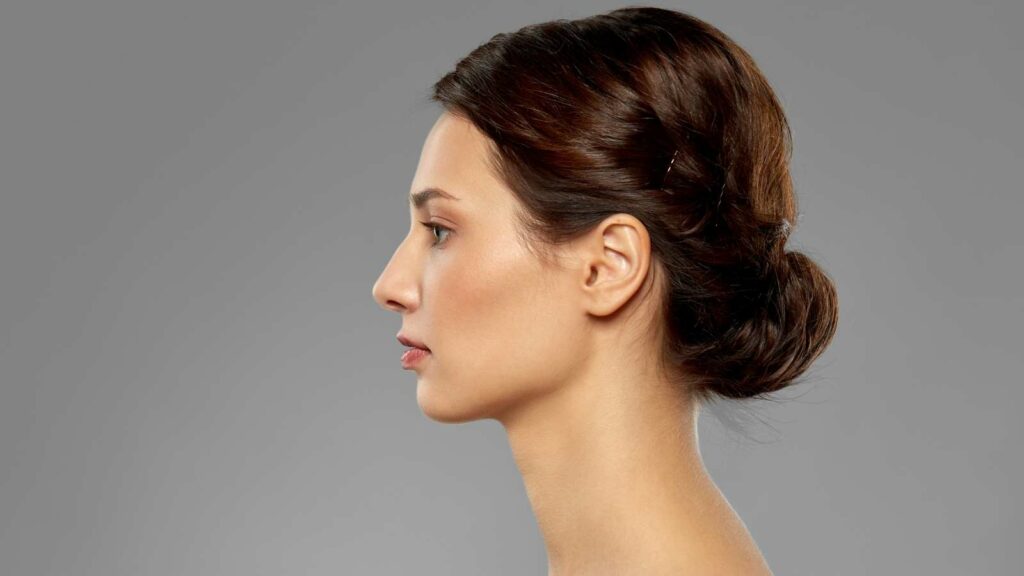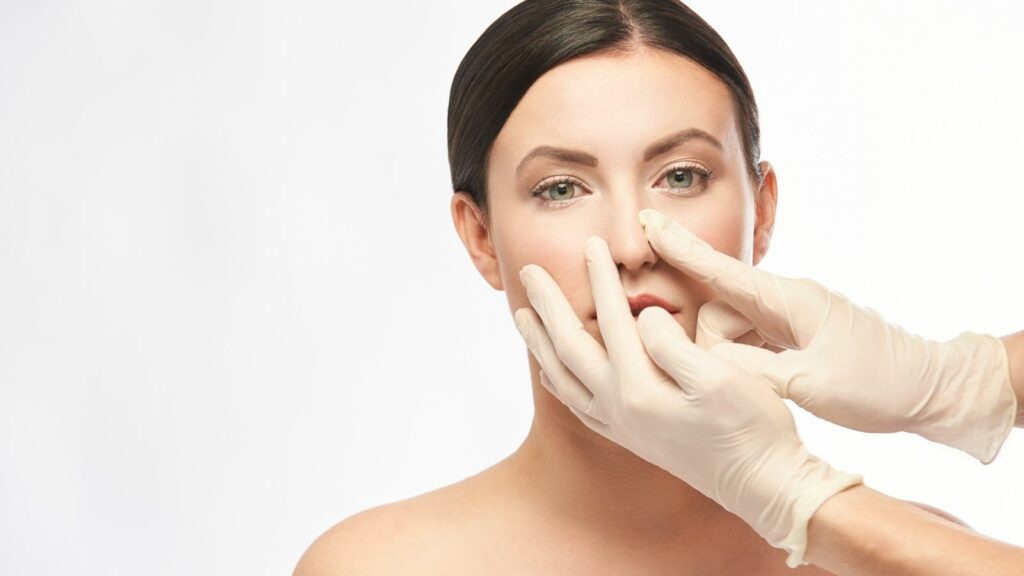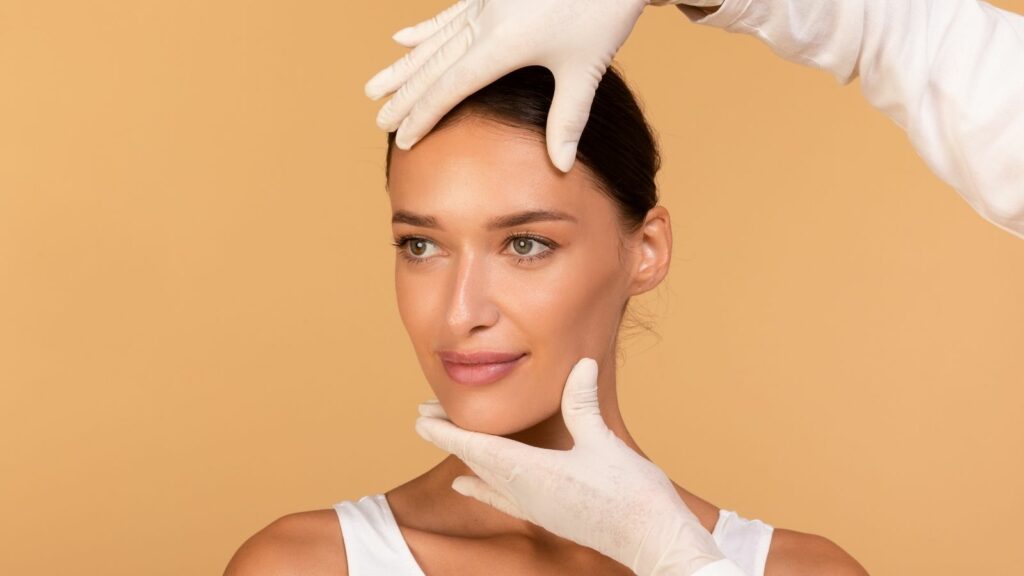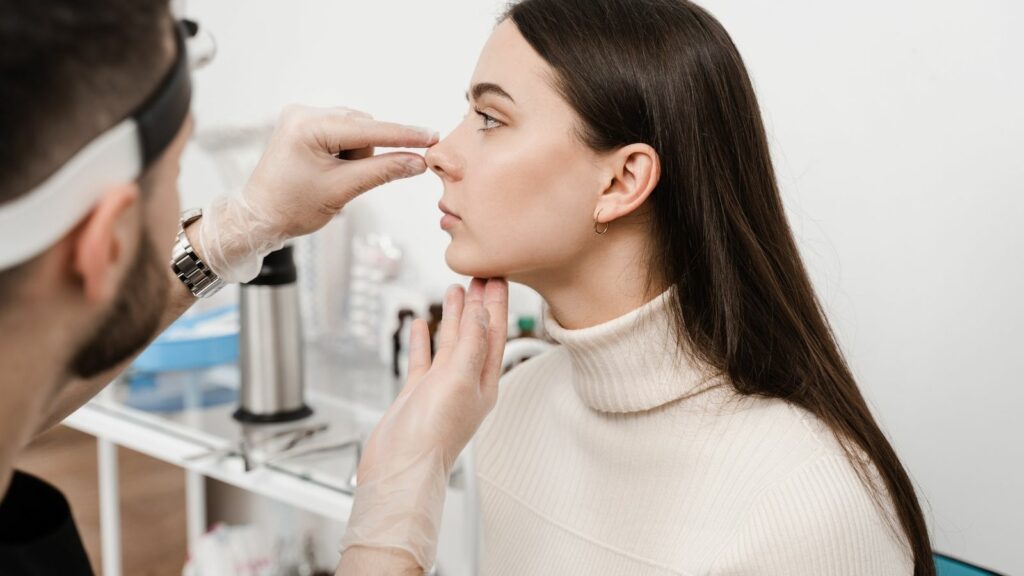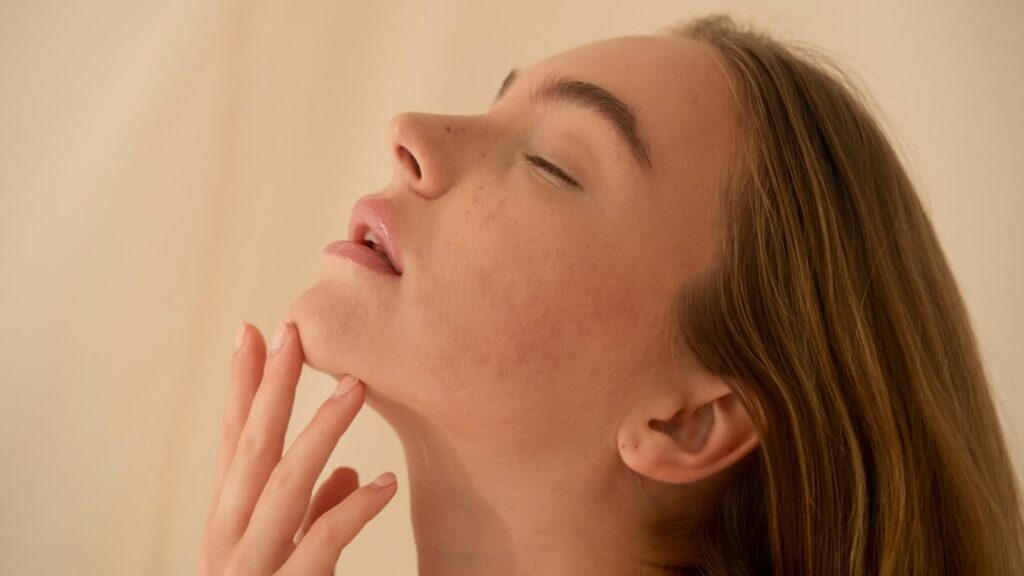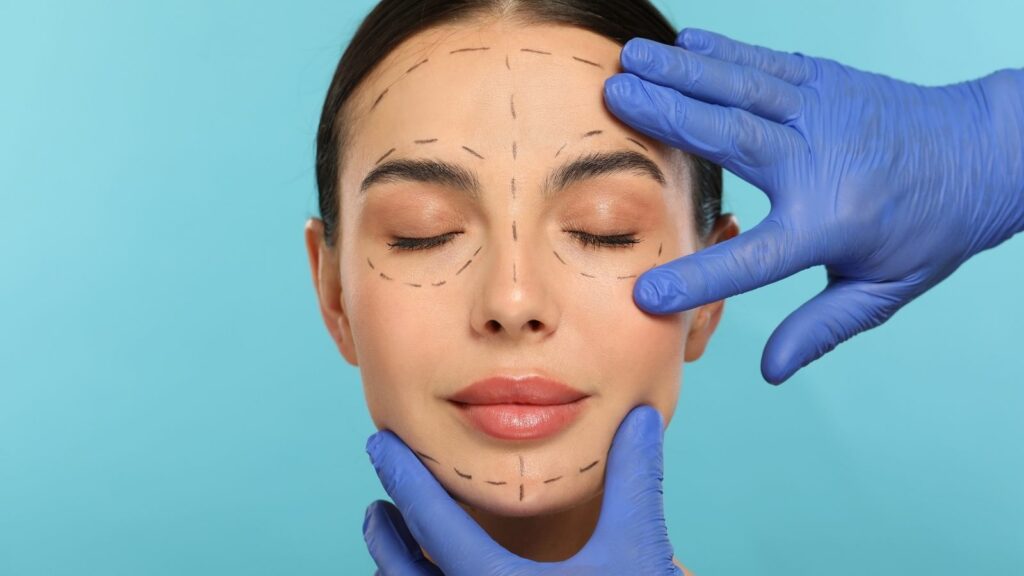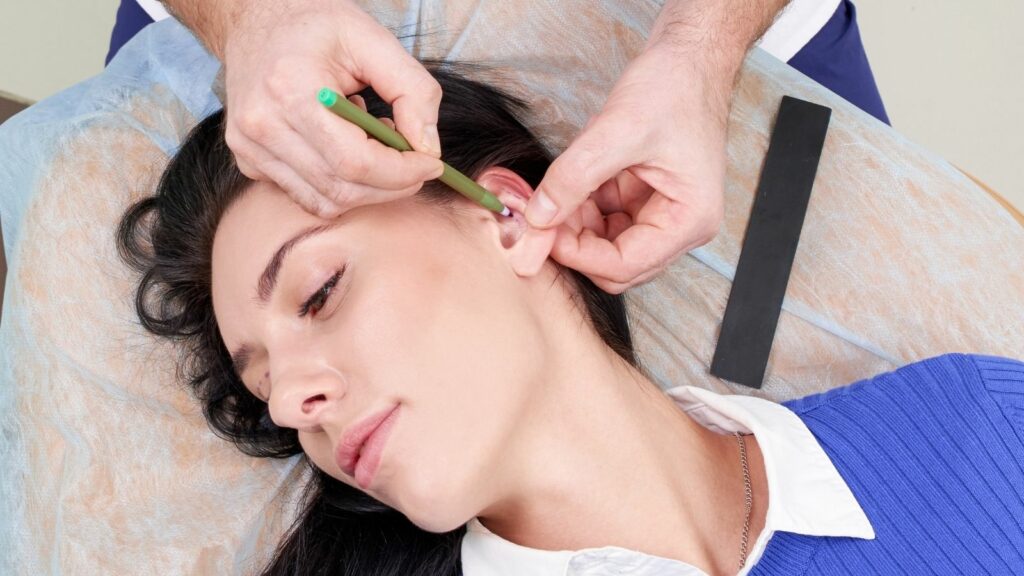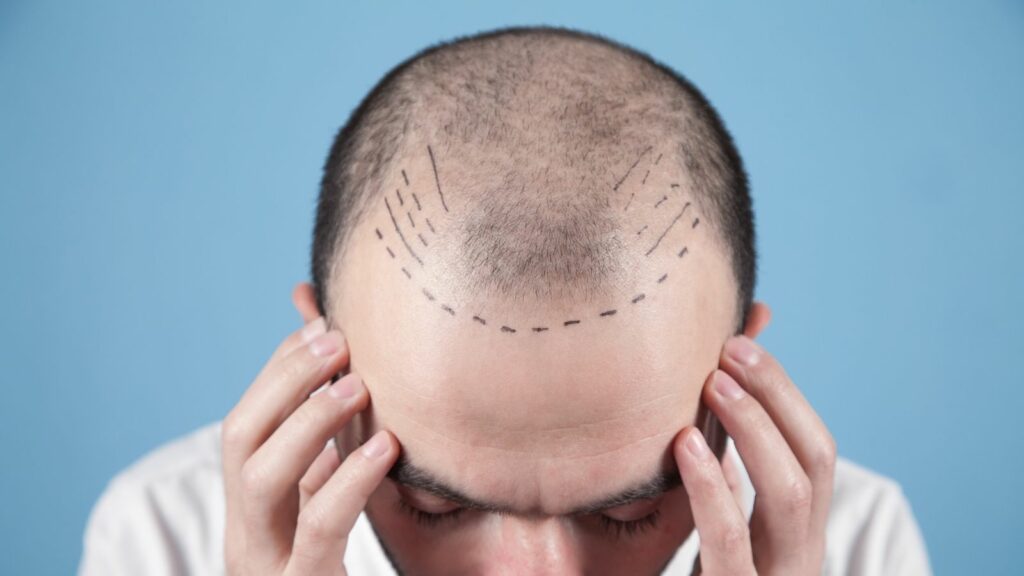Aquiline nose rhinoplasty is the procedure of reshaping the bony and cartilaginous prominence located on the nasal dorsum—known as the “aquiline nose”—through surgical methods, to create a straighter and more aesthetic profile line. The primary goal of this procedure is to achieve a natural appearance that harmonizes with the overall proportions of the face. The aim is not only to eliminate the hump, but also to maintain the person’s facial character while achieving an aesthetic and smooth transition on the nasal dorsum. In this way, the bothersome convex appearance from the profile is permanently corrected, resulting in a balanced outcome that integrates with the facial expression.
What Is An Aquiline Nose?
An aquiline nose, often referred to as a Roman nose, is characterized by a prominent bridge that gives it a slightly curved or hooked appearance. This nasal shape is typically associated with a strong, defined profile and is considered a common hereditary trait in various ethnic groups. While some seek to enhance or preserve this feature, others may opt for cosmetic surgery to soften its appearance.
What Should Be Known Before Having Aquiline Nose Rhinoplasty?
The structure we refer to as the “aquiline nose” actually consists of the fusion of bone and cartilage tissues that form the skeleton of the nose. The upper part of the nose is bone, while the lower part is cartilage. The hump appears at the junction of these two structures when one or both develop excessively. Therefore, aquiline nose correction is an artistic surgery that requires the careful reshaping of this skeletal structure in delicate balance. So, what are the underlying causes of this condition? The answer to “How does an aquiline nose form?” usually lies in a few factors.
The most common causes are:
- Genetic and familial predisposition
- Past nasal traumas or fractures
- Effects of the aging process
As seen, an aquiline nose usually develops outside of one’s control. Unless accompanied by a functional problem such as septal deviation that directly impairs breathing, it usually does not create a functional issue. However, in some cases, an excessively large hump can negatively affect airflow inside the nose. Thus, aquiline nose rhinoplasty can provide not only aesthetic improvement but also functional relief for some individuals.
Is Non-Surgical Aquiline Nose Rhinoplasty Possible, and How Does It Differ from Surgery?
For those who are not keen on surgical procedures or not yet ready, non-surgical options are available. The most well-known is “liquid rhinoplasty” or nasal fillers. It is important to understand that this is a camouflage strategy rather than a treatment.
Liquid rhinoplasty is performed by injecting hyaluronic acid-based dermal fillers. The goal is not to remove the hump, but to conceal it. The filler is injected above the hump at the nasal root and into the depressed areas below at the nasal tip. In this way, the dips and rises on the nasal dorsum are equalized, creating the illusion of a straighter line in the profile view. The structure of the nose does not change, but its appearance is temporarily improved.
This method is a good option for those with a mild aquiline nose who want to “try out” their new look before a permanent change. However, remember that fillers are volumizing substances and do not make the nose smaller—on the contrary, they may make it appear slightly larger. The effect is not permanent and, depending on the filler used, must be repeated every 6 to 12 months.
To summarize the main differences between surgical and non-surgical methods:
Surgery is permanent: Surgery physically alters the bone and cartilage, providing a lifelong solution.
Filler is temporary: The effect of liquid rhinoplasty is limited to several months and requires regular repetition for continuity.
Surgery corrects: Surgery completely removes the hump and can narrow or reduce the size of the nose.
Filler conceals: Liquid rhinoplasty only camouflages the hump and cannot reduce the size of the nose.
Recovery processes differ: Surgery requires weeks of recovery, while filler procedures allow for immediate return to social life.
Is Aquiline Nose Rhinoplasty Performed with ‘Open’ or ‘Closed’ Technique?
There are two main surgical approaches for aquiline nose rhinoplasty: “open” and “closed.” Patients often prefer the closed technique due to the lack of visible scars. However, the choice of technique is determined not by the desire to avoid scars, but by the patient’s nasal anatomy, the size of the hump, and the need for surgical visualization to achieve the safest results.
Open rhinoplasty involves a small incision in the strip of skin called the “columella” that separates the nostrils. Through this incision, the nasal skin is fully lifted, allowing direct visualization of the entire bone and cartilage framework. This wide exposure provides the surgeon with great control and precision, especially in correcting large humps, serious asymmetries, or in complex revision cases. It allows for the most accurate placement of cartilage grafts used for structural support. The disadvantages are a small scar that usually becomes almost invisible over time, and slightly more swelling compared to the closed technique.
Closed rhinoplasty involves making all incisions inside the nostrils. There are no visible external scars, generally less swelling, and the recovery process may be somewhat faster. However, the surgeon operates with limited visibility through narrow channels. This makes the technique more challenging and restricts some complex maneuvers. Therefore, the closed approach is generally preferred for simpler and smaller humps or when minimal changes to the nasal tip are planned.
Ultimately, both techniques have their own advantages, and neither is absolutely superior to the other. An experienced surgeon is proficient in both techniques and will choose the approach that will deliver the safest and most predictable result for the patient’s needs.
What Are the Main Differences Between Modern Aquiline Nose Rhinoplasty Techniques?
Today, there are basically two different surgical philosophies for aquiline nose rhinoplasty: traditional (structural) and preservation rhinoplasty techniques. Both can successfully correct the hump, but their approaches are philosophically quite different.
Traditional (structural) rhinoplasty is based on the “remove and rebuild” principle. In this approach, the excess bone and cartilage tissues forming the nasal dorsum are removed using chisels or rasps. After this process, an “open roof” is created on the nasal bridge. To close this gap and prevent the collapse of the middle third of the nose over time, controlled osteotomies are performed, and cartilage supports known as “spreader grafts” are usually used to reconstruct the roof. This method is highly reliable, especially in crooked noses or complex deformities, as it gives the surgeon full control.
Preservation rhinoplasty, on the other hand, follows the “preserve and reposition” philosophy. The goal in this technique is not to disturb the patient’s natural, smooth nasal dorsum. Instead of shaving the hump from above, a portion of bone and cartilage is removed from underneath the nasal skeleton, lowering the nasal pyramid as a whole. Thus, the natural anatomy of the nasal dorsum is preserved. Potential advantages of this technique include:
- Preservation of natural nasal dorsum contours
- Less tissue trauma
- Generally less swelling and bruising
- A faster recovery period
- Reduced need for grafts to support the middle roof
However, the preservation technique is not suitable for every patient. It yields better results in noses with certain anatomical features and straight axes. The choice of technique is a strategic decision the surgeon makes after examination, based on the patient’s anatomy and goals.
Why Is Bone Reshaping (Osteotomy) Important During Aquiline Nose Rhinoplasty?
Osteotomy is a critical step, especially after removing a prominent hump using the traditional method. Although commonly referred to as “breaking the nose,” this procedure actually involves highly precise and controlled surgical cuts in the nasal bones.
The main purpose of this process is to repair the “open roof” deformity created after the hump is removed. The nasal bones meet at the midline like the roof of a house. The hump is the apex of this roof. When this apex is shaved down, the roof flattens, leaving a gap between the bones. If this gap is not closed, the nose appears overly wide, flat, and unaesthetic from the front.
Through osteotomy, controlled cuts are made on the sidewalls of the nose, making the bones mobile. These bones are then gently moved toward each other to close the open roof. This maneuver narrows the nose elegantly and forms a new, aesthetic, and natural nasal roof. This step is essential for achieving a successful result not only in profile but also in the frontal view.
Why Are Spreader Grafts Used During Aquiline Nose Rhinoplasty?
Modern rhinoplasty philosophy focuses not just on removing excess tissue, but on strategically supporting the nose to maintain long-term structural integrity and function. “Spreader grafts” are one of the most important tools of this philosophy.
These small strips of cartilage, usually harvested from the patient’s own nasal septum, are placed in the middle portion of the nose like supporting columns. Spreader grafts have two main purposes:
Providing Structural Support: After removing the hump, they prevent collapse of the weakened middle third and the development of “inverted V deformity.” They ensure a smooth and natural transition to the nasal dorsum.
Improving Airflow: By widening the internal nasal valve—the narrowest part of the nasal airway—they maintain or significantly improve breathing.
Therefore, spreader grafts are both aesthetically and functionally critical and are used in nearly all aquiline nose rhinoplasty cases involving large humps with traditional techniques.
What Is the Recovery Process After Aquiline Nose Rhinoplasty?
Recovery after aquiline nose rhinoplasty is a gradual process that requires patience. It can take up to a year for the nose to achieve its final shape. The general healing process and points of attention are as follows:
First Week: A protective splint is placed on the nose. This is the period with the most swelling and bruising around the eyes. The splint is removed at the end of the week, and most patients can return to social life.
2-4 Weeks: Swelling and bruising rapidly diminish. The new shape of the nose becomes noticeable, but there is still edema. Strenuous activities should be avoided.
1-3 Months: Most of the swelling subsides. The nose begins to look good in social settings and photographs.
3-12 Months: The period when the final refinements settle. Especially edema at the nasal tip gradually resolves and the nose takes its final shape.
- Sleep with your head elevated for the first few days.
- Apply cold compresses as recommended by your doctor.
- Protect your nose from any trauma.
- Avoid strenuous exercise and sports for the first few weeks.
- Avoid blood-thinning medications and supplements.
- Avoid wearing glasses for a while.
- Be gentle when cleaning your nose and avoid blowing your nose.
Are There Any Risks in Every Aquiline Nose Rhinoplasty?
As with any surgical intervention, aquiline nose rhinoplasty also carries potential risks. However, these risks are minimized by choosing an experienced and specialized surgeon, using the correct techniques, and following postoperative care instructions. Possible risks include:
- General risks related to anesthesia
- Infection
- Bleeding
- Irregularities on the nasal dorsum
- Aesthetically unsatisfactory results
- Under- or overcorrection of the hump
- Rarely, breathing difficulties
- Temporary numbness at the nasal tip
How Long Should One Wait for the Final Results After Aquiline Nose Rhinoplasty?
Patience is the key after aquiline nose rhinoplasty. Although changes begin immediately after surgery, it can take up to a year—or even 18 months in patients with thick skin—for the tissues to fully heal, swelling to subside, and the nose to integrate with the face and reach its final shape.
It is very important to have realistic expectations. The goal of surgery is not to create a “perfect” or someone else’s nose, but to achieve a natural-looking and aesthetically balanced result that suits the individual’s own facial features. A good surgeon will shape the result according to the patient’s facial structure, gender, and personal aesthetic preferences.
Finally, it would be misleading to give an exact figure for the cost of aquiline nose rhinoplasty. The cost of surgery varies depending on the technique used, the hospital where the procedure is performed, the complexity of the operation (primary or revision), and the surgeon’s experience. The most accurate information will be determined after a face-to-face consultation and examination with your doctor.
Frequently Asked Questions
Can an aquiline nose be corrected with rhinoplasty?
Absolutely yes. In fact, correcting the nasal hump is one of the most frequently requested procedures in rhinoplasty. During surgery, we reshape the bone and cartilage that create the hump to achieve natural and aesthetic harmony with your other facial features. The goal is a softer and more balanced profile.
Can surgery fix an aquiline nose?
Yes, surgery is the most permanent and effective method for correcting an aquiline nose. During the procedure, excess bone and cartilage on the nasal dorsum are carefully removed or rasped to create a straight form. Thanks to modern techniques, the aim is to preserve the natural structure while achieving a satisfying and lifelong result both aesthetically and functionally.
Can a nasal hump be corrected without surgery?
Not permanently, but it can be camouflaged temporarily. With filler procedures known as “non-surgical rhinoplasty,” we can fill the depressions above and below the hump, making the nasal dorsum appear straighter. However, this does not remove the hump; it simply creates an illusion, and the effect lasts about 1 year. It is not suitable for large humps.
Which ethnicity is associated with a mild aquiline nose?
Aquiline nose shape is not specific to a single ethnicity; it is a common feature found in many different populations around the world. It is most commonly seen in the Mediterranean, Middle Eastern, and South Asian populations. Therefore, it is more accurate to see it as part of human diversity rather than limit it to a specific ethnicity.
How long does aquiline nose surgery take?
Although it may seem like only removing the hump, surgery generally addresses the nose tip and other structures as a whole. The average aquiline nose surgery takes 2 to 4 hours depending on nasal complexity and additional interventions. The duration is individualized, as every patient’s anatomy is unique.
Can a dip develop in the hump after nose surgery?
This is a risk that can occur if too much of the hump is removed by inexperienced hands. Known as “saddle nose” deformity, we aim to avoid this with modern surgery by preserving the natural nasal dorsum and lowering the hump in a controlled way. In well-planned surgery, this risk is minimal.
Is an aquiline nose attractive?
Beauty and attractiveness are entirely subjective perceptions. For some, an aquiline nose may offer a characteristic and strong expression. What matters is how you feel when you look in the mirror. The purpose of aesthetic surgery is not to fit everyone into a single mold, but to help each person find the balance and appearance that makes them feel best about themselves.
At what age does an aquiline nose develop?
Aquiline nose is usually a genetic trait and begins to become prominent during adolescence, as facial bones and the nose grow rapidly. For this reason, we generally prefer to wait until the age of 16-17, when bone development is complete, before performing rhinoplasty.
What causes an aquiline nose?
There are basically two causes. The first and most common is genetics—a structural trait inherited from family. The second is trauma. A blow to the nose in the past can lead to irregular bone or cartilage healing, resulting in a prominence or hump on the nasal dorsum over time.
Does a “pseudo-hump” go away?
A “pseudo-hump” is when the nasal dorsum is not actually high, but appears so because the nasal tip is low. This is an illusion and does not resolve on its own. The solution is not to rasp the hump, but to surgically raise the nasal tip to the proper height. With the right intervention, the nasal dorsum will naturally appear straight and aesthetic.

